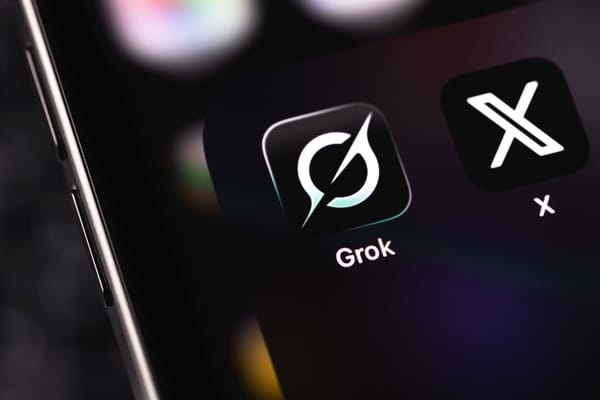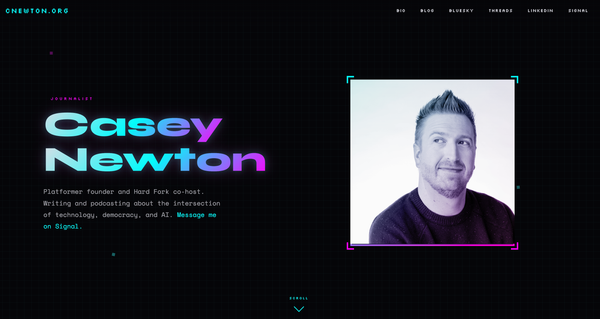The dark horse in the metaverse wars
Is Niantic really building a metaverse for metaverse haters? PLUS: Say hello to Platformer Jobs

Today let’s talk about a concept that we can all agree is well defined and no one is yet sick of talking about: the metaverse.
OK, maybe you are a little tired of hearing about it. For a company often accused of being unable to do anything but copy, Facebook-now-Meta’s announcement this summer that it would pivot to the metaverse has already inspired a remarkable number of clones. As David Pierce notes at Protocol today, the tech world has recently announced “a fashion metaverse, an industrial metaverse, an entertainment metaverse, a gaming metaverse, [and] a shark metaverse.” (He forgot Match Group’s forthcoming dating metaverse, though in fairness I’m trying to forget it too.)
But as oppressive as this wave of announcements can feel, they also tell us something important: this trend — a set of next-generation, portable internet experiences centered on virtual reality headsets and augmented reality glasses — is much bigger than any one company. The more companies that begin to build their pieces of this world, after all, the more likely it is that some of them will succeed. And the ones who succeed in the end might be different than the one we expect at the start.
One company that would seem to be well positioned to capitalize on this trend is Niantic Labs, which was created as an internal startup at Google in 2010 and was spun out as an independent company five years later. I first wrote about Niantic in 2013 in the context of its first game, the science fiction-flavored Ingress. But the company got much bigger three years later when it launched Pokémon Go, which became a cultural phenomenon and generated more than $6 billion in revenue (as of last year) along the way.
From the beginning, Niantic has had all the makings of a metaverse company. Its core products lay animations on top of the real world using software and smartphones. And this year the company announced that it is building a reference design for its own AR glasses, joining companies including Meta and Snap.
And yet when it comes to the metaverse itself, the company is not a fan. “The Metaverse is a Dystopian Nightmare. Let’s Build a Better Reality,” read the headline on a company blog post this summer. CEO John Hanke explained himself this way:
As a society, we can hope that the world doesn’t devolve into the kind of place that drives sci-fi heroes to escape into a virtual one — or we can work to make sure that doesn’t happen. At Niantic, we choose the latter. We believe we can use technology to lean into the ‘reality’ of augmented reality — encouraging everyone, ourselves included, to stand up, walk outside, and connect with people and the world around us. This is what we humans are born to do, the result of two million years of human evolution, and as a result those are the things that make us the happiest. Technology should be used to make these core human experiences better — not to replace them.
Hanke elaborated today in an interview with Steven Levy at Wired:
It takes us away from what fundamentally makes us happy as human beings. We’re biologically evolved to be present in our bodies and to be out in the world. The tech world that we’ve been living in, as exacerbated by Covid, is not healthy. We’ve picked up bad habits—kids spending all day playing Roblox or whatever. And we’re extrapolating that, saying, “Hey, this is great. Let’s do this times 10.” That scares the daylights out of me.
Despite those fears, what Niantic is building is very much consistent with what rivals like Meta and Snap are pursuing. And as of today, the company is inviting other developers to come help realize its vision. During a virtual event this morning, Niantic announced Lightship, an “ARDK” — augmented reality development kit — designed to help developers build experiences using the same building blocks Niantic uses to build Pokémon.
If you’ve played that game, you know that Niantic understands how to place a cartoon character in your immediate surroundings and create ways for you to interact with it — throwing a Poké Ball at a wild Pikachu, for example. But when it launched, the technology could not distinguish between whether you were indoors or outdoors, on grass or on gravel, or whether a large body of water was right next to you.
Lightship offers a way to help developers understand those elements and build custom games and other experiences around them. The long-term goal is to create a crowdsourced, three-dimensional map of the world. In the meantime, the idea is to create software that adapts to your surroundings. If you’re standing on the beach, maybe your phone shows you a monster coming out of the water. If you’re on dry land, maybe that same monster claws out of the grass. Or if you’re indoors, maybe a virtual ball bounces off the table in front of you.
To anyone who has played a recent console or PC game, none of this may sound particularly inspiring. Niantic’s work here is very much state of the art, but the state of the art is primitive compared to the visions that tech companies keep painting for us in their keynotes. As someone who has spent 30 years watching video games radically improve, it’s easy for me to believe that the truly mind-blowing stuff will someday arrive. And most tech progress happens through the kind of steady iteration Niantic showed off today. But I understand why an average citizen could look at all this and shrug.
At the same time, most of the metaverse discourse to date has focused on which of the giants is most likely to dominate. Will it be Microsoft, with its business-focused HoloLens division? Will it be Meta, which just bet the long-term future of the company on consumer-focused mix reality? Or will Apple swoop in after years of working in secret and take the market for itself, just as it did with the iPhone before it?
None of those strike me as particularly bad bets. But it’s probably a mistake to omit from the discussion Niantic, if only because Pokémon Go might be the most popular AR experience created to date. And while the giants’ metaverse ambitions all revolve around new hardware, Niantic has been able to create compelling, mass-market mixed-reality experiences using the smartphone alone — a feat that so far has been matched only by Snap.
That speaks to one reason that I, for one, find metaverse talk compelling: the space is legitimately competitive and mostly unsolved, with both technological and policy concerns to consider. (That makes it distinct from today’s social networks, who are mostly just trying to figure out the best way to make TikTok a tab in their apps while fending off regulators who want to break them up.)
For now, the metaverse isn’t much of a business. No one has yet aggregated enough developers, or enough consumers, to make it much more than a loss leader for future products. Like its peers in the space, Niantic mostly isn’t charging to use Lightship; the exception is if developers want to use its multiplayer features, which let up to five people share the same virtual experience through their phones.
The question now is whether other developers can use Niantic’s tools to build a Pokémon-scale hit — or whether, as my colleague Andrew Webster has argued at The Verge, Pokémon was a fluke. He notes that other efforts built on similarly fanatical fandoms have flopped. Those include Niantic’s own games built on the Harry Potter and Settlers of Catan franchises, as well as Microsoft’s effort to build a similar AR hit using Minecraft.
The bull case would argue that developing new tools in the way Niantic has will enable novel new game mechanics, and that distributing them for free to developers gives the company the best chance to discover them. If there’s even a slight chance a developer could stumble onto a Pokémon-size hit using these tools, I imagine plenty of them will take a look.
I enjoyed Niantic’s keynote today, and I think anyone even a little interested in AR and the future of gaming would benefit from watching it. And after a conversation with Hanke at the company’s offices on Friday, I’m convinced he wants to build an alternative to the metaverse as it has been presented to us so far: as a utopian replacement for a declining civilization.
It’s hard to be opposed to the idea of people spending more time outside, even if takes smartphone games to get them there. And yet after looking at Niantic’s announcements, I wonder if its vision of the future is really all that different from its peers’. An endless parade of entertaining distractions, mediated by technology, placed directly in our field of vision: if that technology gets good enough, I’m not sure it will matter much whether you’re using it outside or not.
Put another way: augment reality enough and it becomes a different reality entirely. And once that day arrives – thanks to Niantic or someone else — I suspect we’ll be sorting through the implications for a very long time.
Platformer Jobs
Hey, Platformer now has a jobs board! You can find it here, stocked with high-quality jobs in tech policy, trust and safety, and related fields at companies including Twitter, Google, Snap, TikTok, and Stripe. As we move forward, you can expect to find compelling open roles in at least two places: the board itself, which is run by a company called Pallet, and here in the newsletter.
My hope is that this experiment serves both to build community and make Platformer a more sustainable media company. To that end, here are some thoughts on how and why I decided to try this. (The information in this section will also live permanently at this link.)
Since I began writing a newsletter in 2017, a powerful community has sprung up around the mailing list. While Platformer readers span a wide range of fields in the technology industry, it has developed a particularly strong following among professionals who work in roles related to tech policy and trust and safety. I believe that these are among the most important jobs in the industry, and that I can provide a valuable service to my readers by helping them find work that is meaningful to them. I also think we all benefit from having smart, talented, motivated people working in these jobs, and I’d love to help more people find their way into this work.
If that's all the jobs board did, it would be worth doing. But I also hope that making Platformer a place to showcase great jobs in the industry attracts more people working in these roles to the newsletter itself. These are the people who, with their emails and Signal messages and participation in Sidechannel, constantly make me smarter and the newsletter better. So in addition to being a service to readers, it's also an exercise in community-building.
There's a business interest, too. Platformer has a healthy subscription base. But from the beginning, all my mentors in the media business have encouraged me to diversify my revenue streams over time. My hope is that the jobs board will enable Platformer's continued growth, and to help me further realize my dream of creating a sustainable tiny media company.
So how does it work?
Companies who want to recruit members of the Platformer community can post jobs to the jobs board for a fee. The board lives here; to view available jobs by company, try this view.
For an additional fee, companies can pay for featured placement in editions of Platformer. The current plan is to place listings in the weekly free edition, which reaches more than 50,000 people, and in at least one paid edition per week.
Nonprofits and academic institutions can post jobs to the board for free by using the code NONPROFIT at checkout. (I review each job posting before it goes up, so for-profit companies can't use this code for free placement.) Select nonprofit and academic roles will be featured in editions of Platformer as well.
Platformer readers who would like to apply for jobs on the board can do so through Pallet. I will never know the identity of anyone who applies for or gets a job through the board.
What’s your ethics policy?
Platformer strives to maintain a divide between the editorial and business operations of the company. To that end, I promise not to let my journalism be affected by whichever companies may or may not be buying ads. For the foreseeable future, I expect that these ads will represent only a small portion of Platformer revenue.
How am I working to avoid conflicts of interest?
- Letting Pallet handle the sales and operations of the jobs board. To the extent possible, I am effectively outsourcing the revenue operations to a third party, roughly mimicking the editorial-sales divide you find in most newsrooms. (I do expect I'll be interacting with recruiters directly on occasion for customer service reasons.)
- Offering free placements to nonprofits and academic institutions in an effort to disperse tech talent more broadly throughout the workforce. (The idea is that this is in my editorial interest but against my economic interest, highlighting the editorial ambitions of the project.)
As with other projects we’ve tried around here, the jobs board is an experiment: if it doesn’t take off, I’ll wind it down. But I’ve been heartened by the early response and am optimistic about the future. As always, share your thoughts with me at casey@platformer.news.
The Ratio
Today in news that could change public perception of the big tech companies
⬇️ Trending down: A look at how Google deceived publishers for years about the purpose and workings of Accelerated Mobile Pages (AMP), resulting in broken trust and an antitrust lawsuit. The unredacted lawsuit is one of the most damning internal Google documents I have ever read. (Sarah Gooding / WP Tavern)
Governing
⭐ About 1 in 8 people told Facebook that their use of the company’s apps is problematic, according to leaked internal research. The latest installment of the Facebook Files adds more fodder to the ongoing discussion about the effects of social networks on mental health. Here are Georgia Wells, Deepa Seetharaman and Jeff Horwitz in the Wall Street Journal:
A Facebook team focused on user well-being suggested a range of fixes, and the company implemented some, building in optional features to encourage breaks from social media and to dial back the notifications that can serve as a lure to bring people back to the platform.
Facebook shut down the team in late 2019.
Facebook faces a new antitrust lawsuit alleging that it copied and crushed a photo-sharing app in 2014. The now-defunct startup, Phhhoto, is represented by Gary Reback, who helped persuade the Justice Department to sue Microsoft in the 1990s. (Sheera Frenkel and Daisuke Wakabayashi / New York Times)
A look at the regulatory forces and social pressures that persuaded Facebook to delete its facial recognition “face prints.” “The decision was in the works for nearly a year, long before the current scandal, championed internally by the company’s artificial intelligence team and supported by policy professionals who believe that regulation of such controversial technologies is coming eventually anyway.” (Elizabeth Dwoskin / Washington Post)
The US Treasury is buying private app data to use in its enforcement actions. “Critics were particularly alarmed that the Treasury acquired access to location and other data harvested from smartphone apps.” (Sam Biddle / The Intercept)
The latest bill to be introduced in Congress with the goal of reining in Big Tech would ban mergers and acquisitions unless the acquiring company could prove it would not harm competition. “The Platform Competition and Opportunity Act is a Senate companion bill to a similar House bill of the same name”; it has bipartisan support. (Ashley Gold / Axios)
A look at the proliferation of libel suits against Netflix as it pushes further into documentaries. The company has argued that it is simply a distributor of the content and should not be liable, but judges are allowing cases to proceed. (Eriq Gardener / Hollywood Reporter)
Hackers in Turkey allegedly used Twitch to launder $10 million. The fraud was uncovered by people who analyzed the recently hacked source code. (Muhdan Saglam / Middle East Eye)
Elon Musk did a Twitter poll to determine whether he should sell some of his Tesla stock and pay taxes on it. More than 3.5 million people voted, with 58 percent voting yes. Musk promised to abide by the result. (Faiz Siddiqui / Washington Post)
Industry
⭐ A look at NFT.NYC, a coming-out part for non-fungible tokens as a cultural mega-event. Kevin Roose had all the fun at the New York Times:
“This, to me, is Woodstock,” said Kenn Bosak, a Philadelphia-based NFT collector, who had a small face tattoo that turned out, under close inspection, to be the letters N-F-T. (“I got it the day I became a millionaire,” he explained.)
Woodstock — which signified the mainstream embrace of a youthful counterculture — is actually a decent comparison to a gathering like NFT.NYC, albeit on a different scale. The crypto business is booming, with Bitcoin and Ethereum prices near all-time highs and new money arriving by the truckful. Big corporations are co-opting the language and aesthetics of crypto to market themselves to young customers, and celebrities are promoting crypto exchanges and releasing their own NFTs. And while there are still plenty of crypto skeptics, including U.S. regulators, the industry’s reputation as a haven of criminality and tax fraud is disappearing. Today, the emerging view seems to be that crypto is cool — something not even the truest believers would have argued until recently.
Meta is considering opening up physical stores to showcase its current and future hardware offerings. It and Netflix are now the only US two tech giants without physical stores. (Mike Isaac / New York Times)
Meta’s Maxine Williams on making a more inclusive metaverse. Among other things, the company “is partnering with outside groups such as Howard University, the Organization of American States and organizations in Africa to collect feedback about the potential impact of its technology on diverse populations.” (Naomi Nix / Blooberg)
Pinterest reported better-than-expected earnings despite a drop in monthly users. It reported 444 million users, lower than the expected 460 million. (Salvador Rodriguez / CNBC)
Those good tweets
They say you have to set your clocks back on Sunday but I’m going to do my own research.
— R. Eric Thomas (@oureric) 1:19 AM ∙ Nov 6, 2021
iPhone Photos will make a lil movie of the saddest month of your life w/o your permission
— julia shiplett (@juliashiplett) 10:10 PM ∙ Nov 7, 2021
— François Chollet (@fchollet) 6:06 PM ∙ Nov 4, 2021
Adding sad violins to my ex’s bs apology text
— JAX (@Jax) 12:09 AM ∙ Nov 5, 2021
Ft. the incredible @LindseyStirling ❤️🎻
vm.tiktok.com/TTPdYgNX6P/
Talk to me
Send me tips, comments, questions, and jobs! casey@platformer.news.





